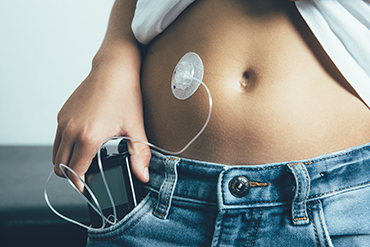Ultrasound might become a new way to manage diabetes
This form of energy releases insulin in mice. That might someday help control blood sugar in people

People with diabetes monitor their blood sugar to avoid organ damage. Many take drugs that affect insulin, a hormone that controls blood sugar. Researchers are exploring ultrasound as an alternative to those drugs.
AzmanJaka/E+/Getty Images Plus; adapted by L. Steenblik Hwang
During pregnancy, parents love to take a first peek at the baby developing inside mom’s body. Special sound waves, with a frequency too high for the human ear to hear, make this imaging possible. But these ultrasound waves can do much more. Researchers are now exploring whether this type of energy can control diabetes before it damages the body.
In most people with diabetes, the body doesn’t respond normally to the hormone insulin. In some people, the body doesn’t make insulin at all. Insulin’s job is to move a simple sugar (glucose) circulating in our blood into cells throughout the body. Glucose fuels the growth and activity of those cells. If insulin can’t do its job, glucose builds up in the blood. Over time, that can damage organs.
Vesna Zderic is a biomedical engineer at George Washington University. That’s in Washington, D.C. Zderic uses her engineering knowledge to solve medical problems. In one of her projects, she has focused on the cells that make and release insulin. These cells, called beta (Bay-tah) cells, live in the pancreas (PAN-kree-us). This organ, which sits behind the stomach, is about 15 centimeters (6 inches) long.
Other researchers had shown that ultrasound could prompt brain cells to release certain signaling chemicals. Zderic and her colleagues wondered if ultrasound might similarly trigger beta cells to release insulin. Many diabetes drugs affect beta cells this way. But those drugs can be costly, especially for lifelong treatments. And diabetes drugs often have unpleasant side effects.
If ultrasound could trigger beta cells to release insulin, it might halt the common form of diabetes in its tracks. That would be important, Zderic reasoned. People with advanced diabetes can develop serious damage to the heart and kidneys. They may even become blind. At that point, many of their beta cells will have died. Their body will no longer be able to make much insulin, if any.
So Zderic’s team figured out a way to treat cells inside the pancreas with ultrasound. And in new tests, the researchers confirm that the technique works — at least in mice.
“Common diabetes drugs often upset the digestive system or harm the kidneys,” observes Tania Singh. She’s a biomedical engineer who worked in Zderic’s lab as a student. Like her mentor, she hopes the ultrasound treatment might one day offer a way to avoid these drugs’ side effects.
The need to manage glucose
Every time you eat a meal, your digestive system breaks down food into its chemical building blocks. One of these is glucose. Once released in the gut, glucose will travel through the blood to body parts that need energy to function. The heart pumping at 60 beats per minute, for instance, requires a regular supply of energy from food sources.
Throughout the body, cells need to take up glucose to turn its chemical energy into a usable form. The hormone insulin is a glucose sensor. As blood glucose levels rise, insulin acts as a key to unlock the cells and let glucose in. That removes the sugar from the circulating blood.
But that system is broken in diabetes.
In type 1 diabetes, the body’s own immune system kills the insulin-making beta cells. That means the body doesn’t have the key for managing glucose. In type 2 diabetes, the body makes insulin, but cells don’t respond to it as they should. The key is broken.
When the key for removing glucose is missing or broken, sugar levels in the blood will rise to abnormal levels. Very high levels can damage tissues. (Doctors diagnose diabetes when blood glucose levels exceed 125 milligrams per deciliter after fasting. Normal levels are 100 or less.)
Earlier, Zderic’s team had zapped beta cells growing in a dish with a five-minute beam of continuous ultrasound. That boosted the cells’ insulin release. The researchers reported the findings two years ago. Singh tackled the next step: testing to see if beta cells would do the same thing in healthy mice. The team chose this animal because its pancreas is similar to the human organ.
For the test, they treated one group of mice with ultrasound and left a second group untreated. (Such untreated groups are known as controls.) After numbing the mice, Singh measured the insulin levels in each animal’s blood. Then she put both groups of mice on small stretchers and placed an ultrasound probe on their bellies. She then turned on the ultrasound in the treatment group for five minutes. Afterward, she again measured blood insulin levels in both groups.
Treatment upped insulin levels by about 20 percent. That increase was similar to the results for beta cells tested in a dish. At the same time, insulin levels fell in the control animals. The ultrasound increased the temperature of the surrounding tissue. But it didn’t cause any skin burns in the mice. And the pancreas and nearby organs weren’t injured.
Singh described her team’s findings at a meeting of the Acoustical Society of America in May. The meeting took place in Louisville, Ky.
New method needs more testing
These results are intriguing, says Gabriela Da Silva Xavier. She works at the University of Birmingham, in England. There, she studies how diabetes disturbs the normal response of cells to glucose and insulin. Still, as promising as the data appear, Da Silva Xavier thinks the researchers will need to answer many more questions.
For one, beta cells make up only 1 to 2 percent of cells in the pancreas. “It’s really important to check if ultrasound triggers the release of chemicals from any other cells,” Da Silva Xavier says. After all, those other cells perform important tasks. Some digest food. Some produce other hormones.

That release of other chemicals could happen if ultrasound affects the cells’ outer membrane. If the cell were a soap bubble, the membrane would be the soap layer that surrounds the pocket of air. Beta cells may release insulin because the ultrasound vibrations make their membranes leaky. If that happens to membranes of other cells in the pancreas, their contents may spill out, too.
But a different mechanism might also explain the effect of ultrasound on insulin, says Julianna Simon. She is an acoustics expert at Pennsylvania State University, in State College. She was not involved in the project.
“I think the treatment basically massages the pancreas,” she says. “It sends energy, in the form of a pressure wave, into the body.” There, she says, it likely “compresses and expands the tissue.” This pancreas massage might cause the release of insulin without changing the cell membrane.
Zderic’s team is testing several theories for the effect of sound waves on the cells in the pancreas. The researchers also will study how to target only the beta cells. They’ll also gauge how long they need to zap them to lower blood glucose levels.
They plan to test the method repeatedly on mice that are already obese or diabetic. That will better mimic treating people recently diagnosed with diabetes. Next, the researchers hope to study larger animals, such as pigs. If all those tests go well, Zderic’s team may begin safety studies in human volunteers.
What’s the team’s long-term vision? “It may be possible to implant a device on the pancreas that’s linked to a blood glucose monitor,” Singh says. “When the sensor detects high glucose levels, the device would apply ultrasound to release insulin. When glucose levels are back to normal, it would stop.”
Says Da Silva Xavier, being able to do that “would be brilliant.”
This is one in a series presenting news on technology and innovation, made possible with generous support from the Lemelson Foundation.







